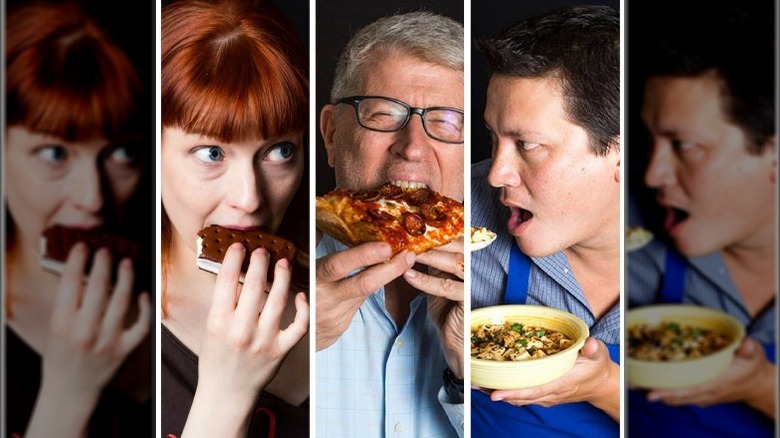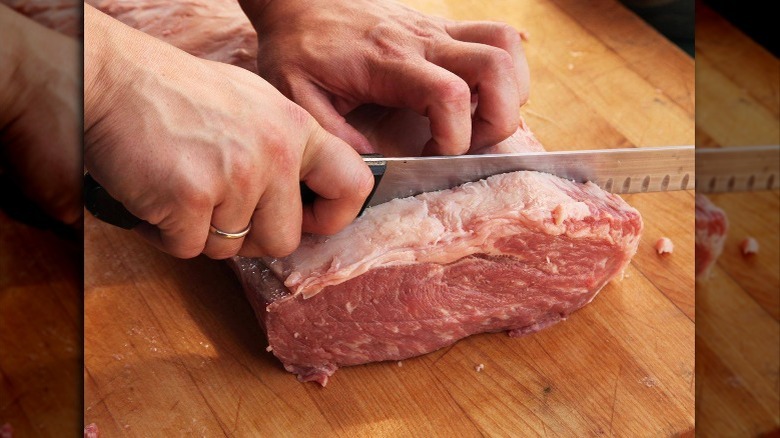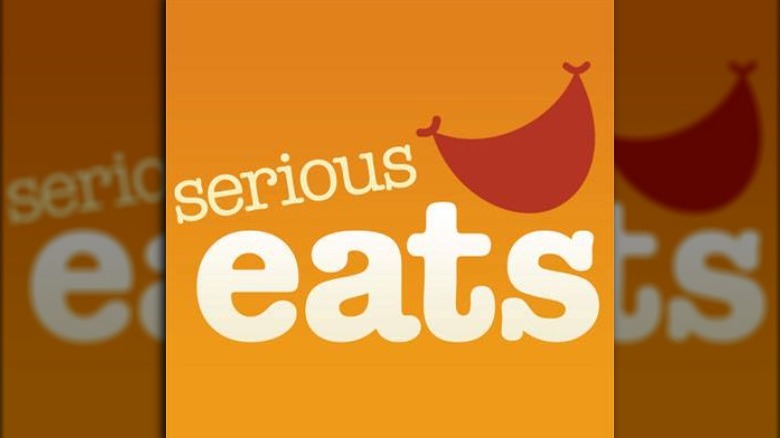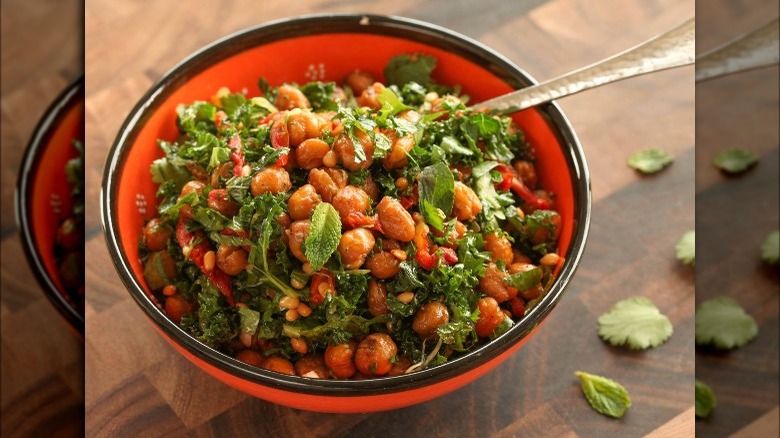The Untold Truth Of Serious Eats
Have you ever browsed through the popular food blog Serious Eats? We know we have. The site is a haven for foodies, offering a plethora of test kitchen-approved recipes, as well as how-to guides to ingredients and cooking techniques, kitchen equipment reviews, and long-form dives into topics ranging from food history to guides to eating and drinking.
Serious Eats is one of the internet's food blog OGs, established way back in 2006 in an era when other popular recipe websites such as Deb Perelman's Smitten Kitchen and Molly Wizenberg's Orangette got their start. In fact, those early 2000s years would see an explosion of food blogs and recipe sites, including the founding of Food52 in 2009 (per Inc.), and recipe developer Molly Yeh's My Name is Yeh in the same year. Since that time, Serious Eats has become a juggernaut, remaining one of the 'net's most-visited food websites, ranked #24 in the category and with more than 8 million views per month (via Similarweb). Read on to learn all about the site, its history, and its enduring popularity.
Entering the blogosphere with an expert at the helm
Recipe website and all-around source of food information Serious Eats got its start way back in 2006, per the official website, when the internet was still coming into its own as a commonly used resource (remember those days?!). The site was started by Ed Levine, a well-known New York City-based food writer who regularly contributed to the New York Times. Levine's articles were known for being obsessive searches for the "best of the best" of some of that city's most iconic eats, such as the perfect hamburger (via Splendid Table) and the idyllic slice of pizza (via the New York Times).
In the early aughts, Levine brought that quest for perfection to his very own website, which he christened Serious Eats, envisioning it "as a haven for enthusiastic and opinionated eaters just like him," as noted on the site. As he recalled in an interview with Grub Street, his original plan was to start a cooking channel on television, but when funding fell through, Levine followed the advice of a former boss who told him, "Start a blog. Blogs are changing the face of media."
The early days of Serious Eats
In 2005, New York Times food writer Ed Levine launched Ed Levine Eats into the still-nascent blogosphere (via Grub Street). After raising investment funding and hiring editors, the site was rechristened Serious Eats, and it made its debut in December of 2006.
From the start, the plan was to bring a Food Network-level of coverage to the internet, according to the Grub Street article. In those early days of food websites, bloggers pretty much had free reign to experiment with format and see what worked in this new medium. As fellow New York Times food writer Pete Wells recalled in the interview with Grub Street, bloggers were learning how to write for the 'net: "What does the internet want? What is it trying to tell us? What do we have to do to make it happy?"
As such, Serious Eats was free to play around with a wide variety of subjects, ranging from "food crawls" that had the blog's youthful founding editors criss-crossing New York City, to the site's ever-popular taste-tests of items such as store-bought eggnog and all the varieties of Spam.
"When Serious Eats was young and lean and had very little freelance budget, the editors took on all kinds of projects ourselves," former managing editor Carey Jones recalled for Grub Street. "My days could be spent in a Zipcar gathering bagels from deepest Queens, or driving to New Jersey because NYC supermarkets didn't have a particular kind of frozen apple pie for a taste test."
Serious Eats recipes are serious business
The food blog Serious Eats is undoubtedly best known for its plethora of recipes for everything from homemade Devil Dogs to authentic Cajun gumbo.
One thing that sets this foodie site apart from other recipe havens, though, is the exhaustive information offered alongside each recipe. Unlike many other food blogs that might publish a recipe alongside a short intro, Serious Eats tends to attach a substantial article to each one so you can learn more about the food you're making. A recipe for Brazilian grilled cheese skewers, for example, goes into the history of this Rio de Janeiro specialty and how it's enjoyed today; likewise, a recipe for Indonesian fried rice includes a primer on kecap manis, the Indonesian soy sauce that's an essential flavoring in the dish.
Much of this exhaustive recipe coverage — as well as the extensive, almost obsessive testing that each published recipe goes through — can be attributed to the reign of J. Kenji López-Alt, the site's former culinary director and current culinary consultant (via Serious Eats). López-Alt, a former writer and recipe developer at Cook's Illustrated, joined founder Ed Levine way back in 2009, coming on to contribute painstakingly tested recipes under his column "The Food Lab."
"Within three months, Kenji's first Food Lab column got 144,000 page views, which was how we measured success at that time," Levine recalled in an interview with Grub Street. "That was 10 times what any recipe post on Serious Eats had gotten at that point."
The food world's take on Serious Eats
From its early days as an experimental food blog and recipe site, Serious Eats garnered the attention — and praise — of food world professionals.
"It was to me, in its own way, almost Jonathan Gold-esque," said celebrity chef Marcus Samuelsson in an interview with Grub Street, referencing the lauded Los Angeles Times restaurant critic who passed away in 2018 (per the newspaper). "It really piqued your curiosity, it got you to go places."
New York Times restaurant critic Pete Wells, meanwhile, also admired the nascent site's fresh take on dining out. "I remember really liking the restaurant coverage, because it seemed like it wasn't driven by the industry and the scene and publicity — it was just what they felt was cool and good, and it had an anthropological streak," he told Grub Street.
And it's not just the pros who love Serious Eats: Home cooks, too, are dedicated fans of the site. Reddit has a whole Subreddit, r/seriouseats, devoted to the blog. There, users share photos and reviews of dishes they've made using Serious Eats recipes. "Nothing like Kenji's bucatini carbonara," one post exclaims, alongside a photo of glossy, egg yolk-slicked pasta. "First time making carnitas. They were amazing!" another post proclaims.
What Serious Eats offers today
Rather than fading into the background as it has aged, the food blog and recipe site Serious Eats continues to grow as it approaches its 15th anniversary. In September 2020, the site was acquired by digital publishing giant Dotdash (via Axios). While the exact terms of the deal were not published, the acquisition was large enough to make Dotdash pass the finish line as one of the largest digital food and beverage publishers today. In an interview with Axios, Dotdash CEO Neil Vogel spoke of plans to inject a significant amount of cash into Serious Eats to help it reach bigger audiences than ever before in its history.
"To make a food site work now, you have to make GIFs. You have to have incredible video capabilities," Vogel said. "You have to explore the cultural history of recipes and talk about nutrition. All these things you never had to do five years ago, but now you have to do them."
Perhaps drawing upon some of that new capital, Serious Eats significantly redesigned its website in May 2021, sporting a fresher homepage design, faster load speeds, and fewer ads (via Serious Eats).
"These changes are all exciting, but they're also just the beginning," former editor-in-chief Niki Achitoff-Gray wrote at the time. "Over the coming months, you can look forward to further communications from us as we work toward cross-testing old recipes, adding more reporting to past articles, supplementing recipes with step-by-step photography, and making our commitment to diversity, equity, and inclusion more transparent and measurable."





